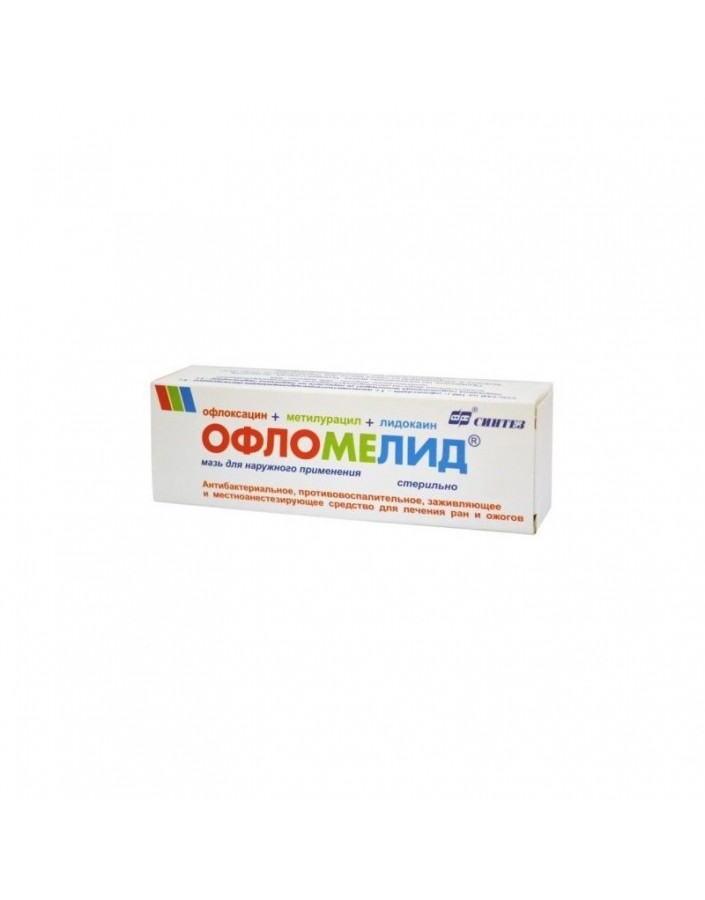




Security policy (edit with Customer reassurance module)

Delivery policy (edit with Customer reassurance module)

Return policy (edit with Customer reassurance module)
OFLOMELID® (ofloxacin 1% + Methyluracil 4% + Lidocaine 3%) ointment for external use
Pharmacotherapeutic group
antimicrobial combination agent
Trade name of the drug
Oflomelide®
Dosage Form
ointment for external use
Description
ointment white or almost white.
Pharmacological properties
Oflomelide® is a combined preparation, has antimicrobial, anti-inflammatory, local anesthetic, regenerating effect. The active substances are Ofloxacin, methyluracil and lidocaine.
Ofloxacin is a broad spectrum antimicrobial agent from the group of fluoroquinolones. It has a bactericidal effect due to the blockade of DNA gyrase in bacterial cells. DNA gyrase is necessary for replication, transcription, repair and recombination of bacterial DNA. Its inhibition leads to the unwinding and destabilization of bacterial DNA and, consequently, to the death of a microbial cell.
Microorganisms highly sensitive to ofloxacin (IPC ≤ 0.5 mg / l):
Gram-positive aerobes - Staphylococcus aureus methi-S (methicillin-sensitive strains), Staphylococcus coagulase negative (coagulase-negative staphylococci: Staphylococcus epidermidis, Staphylococcus saprophyticus, Staphylococcus haemolyticus, a body, a cell, a woman, a woman, a woman, a woman, a phytoxia, aureus methi-S)
Gram-negative aerobes - Aeromonas hydrophila, Bordetella spp., Brucella spp, Campylobacter jejuni, Citrobacter spp. (including Citrobacter freundii), Enterobacter spp. (including Enterobacter cloacae, Enterobacter aerogenes, Eswithherichia coli, Haemophilus ducreyi, Haemophilus influenzae, Haemophilus parainfluenzae, Klebsiella spp. (including Klebsiella pneumonia), Moraxella (Brahamella) catarrhalis, Morganella morganii, Neisseria gonorrhoeae, Neisseria meningitides, Plesiomonas spp., Proteus spp. (Proteus mirabilis, Proteus vulgaris (indole + and indole -)), Providencia spp., Salmonella spp., Serratia (including Serratia marcescens), Shigella spp. (including Shigella sonnei), Vibrio spp. (including Vibrio cholerae, Vibrio parahaemolyticus), Yersinia spp. (including Yersinia enterocolitica);
anaerobes - Clostridium perfringens, Helicobacter pylori, Propionibacterium acnes;
other - Chlamydia trachomatis, Legionella spp., Mycoplasma spp. (including Mycoplasma hominis).
Microorganisms, moderatelyfeel-bodytoofloxacin: Acinetobacter spp. (including Acinetobacter calcoaceticus), Bacteroides fragilis, Bacteroides urealyticus, Chlamydia psittaci, Gardnerella vaginalis, Enterococcus faecalis, Mycobacterium tuberculosis, Mycobacterium leprae, anaerobicgram-positivecocci (Peptococcus spp., Peptostreptococcus spp., Pseudomonas spp. (including Pseudomonas aeruginosa), Streptococcus spp. (att.h. Streptococcus pyogenes, Streptococcus pneumoniae, Streptococcus viridians) - onlypenicillin-sensitivestrains, Ureaplasma urealyticum.
Microorganisms, resistanttoofloxacin (Ipc > 1 mg/l): Acinetobacter baumannii, moststrains Enterococcus spp., Listeria monocytogenes, Nocardia spp, (att.h. Nocardia asteroids), methicillin-resistantstrains Staphylococcus aureus and Staphylococcus spp. (Staphylococci methi-R), Treponema pallidum.
Methyluracil - stimulantreparationstissue. Possessesanabolicassets-ness. Accelerates the processes of cell regeneration in wounds, accelerating the growth and granulation maturation of the tissue and epithelialization.
Lidocaine has a local anesthetic effect due to blockade of Na + channels, which prevents the generation of impulses at the end of sensitive neurons and conduction of impulses along nerve fibers. When applied externally dilates blood vessels, has no local irritating action.
Water-soluble (hydrophilic) and hypo-molar basis of the ointment is a mixture of polyethylene oxides (polyethylene glycols) with a molecular weight of 400 and 1500 (PEO-400 and PEO-1500 or PEG-400 and PEG-1500), providing a dehydrating (moisture-absorbing) and osmotic effect on the fabric, which is 20 times more powerful than 10% sodium chloride solution and lasts up to 18-20 hours.
Indications for use
Infected wounds of various localization and etiology in the first (purulent-necrotic) phase of the wound process including accompanied by severe pain syndrome (infected burns of II-IV century, pressure sores, trophic ulcers, postoperative and post-traumatic wounds and fistulas, wounds after opening abscesses, phlegmon, after surgical treatment of abscessing furuncles, carbuncles, hydradenitis, with unsupported wristbands, abscesses, hydradenitis, wrinkles;.).
Individual hypersensitivity to the components of the drug, pregnancy, lactation, children under 18 years of age.
Dosage and administration
Outwardly, 1 time per day for 1 -2 weeks. After the standard treatment of wounds and burns, the ointment is applied directly to the wound surface with a thin layer (after which a sterile gauze dressing is applied) or a gauze dressing with subsequent application to the lesion. Tampons soaked in ointment, loosely fill the cavity of purulent wounds after their surgical treatment, and gauze turunda with ointment is introduced into the fistulous passages.
In the treatment of purulent wounds, ointment is used 1 time per day, in the treatment of burns - daily or 2-3 times a week, depending on the amount of purulent discharge. The maximum daily dose should not exceed 100 g. The duration of treatment depends on the dynamics of cleansing wounds from purulent exudate and the timing of relief of the inflammatory process.
Allergic reactions.
Interaction with other drugs
There are no cases of drug interactions that would reduce the effectiveness and safety of the drugs used.
Storage conditions
In the dark place at a temperature of from 15 to 25 ° C.
Keep out of reach of children.